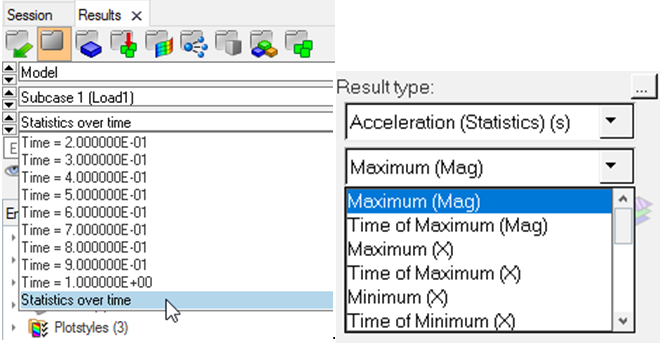ACCELERATION
I/O Options and Subcase Information Entry The ACCELERATION command can be used in the I/O Options or Subcase Information sections to request acceleration vector output for all subcases or individual subcases, respectively.
Format
ACCELERATION(sorting,format,form,rotations,random,peakoutput,fourier,type,statistics) = option
Definitions
| Argument | Options | Description |
|---|---|---|
| sorting | <SORT1, SORT2> Default = blank |
This argument only applies to the PUNCH format
(.pch file) or the OUTPUT2 format
(.op2 file) output for normal modes,
frequency response, and transient subcases. It
will be ignored without warning if used elsewhere.
|
| format | <HM, H3D, HG, OPTI, PUNCH, OP2, PLOT, HDF5, blank> |
|
| form | <COMPLEX, REAL,
IMAG, PHASE,
BOTH> Default (HM only) = COMPLEX Default (all other formats) = REAL |
|
| rotations | <ROTA, NOROTA> |
|
| random | <PSDF,
RMS, PSDFC> No default |
Output is available in the .h3d and
.h5 formats. 5
|
| peakoutput | <PEAKOUT> Default = blank |
If PEAKOUT is present, only the filtered frequencies from the PEAKOUT card will be considered for this output. |
| type | <NORMAL> |
|
| Fourier | <FOURIER> Default = blank |
Accelerations are output for Modal Transient Response Analysis with Fourier Transformation. |
| statistics | <STATIS, OSTATIS, or blank> | Results of Acceleration Statistics over time in a Transient
Analysis are controlled by this option. 15
|
| option | <YES,
ALL, NO,
NONE, SID> Default = ALL |
|
Comments
- When the ACCELERATION command is not present, acceleration results are not output.
- Acceleration output is only available for Frequency Response, Transient Analysis, and Response Spectrum solution sequences.
- The form argument is only applicable for Frequency Response Analysis. It is ignored for other analysis types.
- The forms BOTH and COMPLEX do not apply to the .frf output files.
- Multiple formats are allowed on the same entry; these should be comma separated. If a format is not specified, this output control applies to all formats defined by the OUTPUT command, for which the result is available. See Results Output by OptiStruct for details about supported output formats for different analysis types.
- Multiple instances of this card are allowed. If instances are conflicting, the last instance dominates.
- For optimization, the frequency of output to a given format is controlled by the I/O option OUTPUT.
- In general, HyperView does not recognize the SORT2 format for results from the .op2 file. When results are output only in SORT2 format (<Result Keyword> (SORT2, OUTPUT2, ...)), the results are written by OptiStruct into the .op2 file in SORT2 format, but when the .op2 file is imported into HyperView, the results in SORT2 format are not recognized. Therefore, the SORT1 option is recommended for results output in OUTPUT2 format and SORT2 option is recommended for results output in PUNCH format.
- Results in binary format (.h3d or .op2) are always output in PHASE/MAG form, regardless of the options specified in the FORM field. The corresponding post-processors (HyperView/HyperGraph) can easily convert the PHASE/MAG format to the required formats. Results in ASCII formats are output in the specified/requested FORM.
- The abbreviations ACCE and ACCEL are interchangeable with ACCELERATION.
- format=OUTPUT2 can also be used to request results to be output in the Nastran output2 format (.op2 file).
- For NORMAL acceleration output, the surface grids are automatically selected from within the specified GRID SET. Alternately, if option=ALL is input, the normal acceleration is output for all surface grids in the model. Normal results are only available for Frequency Response Analysis and in the H3D format.
- The FREQ and TIME options are only valid for Modal Transient Analysis with Fourier transformation. When FREQ is present, the accelerations in frequency domain would be output in a dummy frequency subcase, which shares the same ID with the transient subcase.
- The HDF5 output is printed to a
.h5 binary results file. Refer to the .h5 file for details of the supported analysis types and
elements with the .h5 output format.
For details about the old HDF5 format (.hdf5), refer to PARAM, HDF5 and .hdf5 file.
- Acceleration Statistics are
supported for Direct and Modal Linear Transient Analysis types.
Only H3D output is supported for Acceleration Statistics.
The following statistics over time are output for Transient Analysis when STATIS or OSTATIS is specified with Acceleration.- Statistics
- Supported Acceleration Result Types
- Minimum and Time of Minimum
- X-component, Y-component, Z-component
- Maximum and Time of Maximum
- Magnitude, X-component, Y-component, Z-component
- Absolute Maximum and Time of Absolute Maximum
- X-component, Y-component, Z-component
- Arithmetic Mean, Root Mean Square (RMS), Variance, and Standard Deviation
- Magnitude, X-component, Y-component, Z-component
The acceleration statistics can be viewed in HyperView after loading the H3D file, under Statistics over time option at the end of the timestep list in the Results Browser. Then, various statistics can be chosen from the sub-menu under Acceleration (Statistics) (s).
Figure 1.